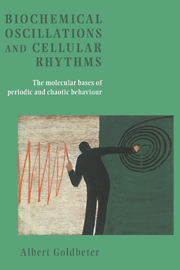Book contents
- Frontmatter
- Contents
- Foreword to the English edition by Michael Berridge
- Foreword to the French edition by Ilya Prigogin
- Preface
- 1 Introduction
- Part I Glycolytic oscillations
- Part II From simple to complex oscillatory behaviour
- Part III Oscillations of cAMP in Dictyostelium cells
- 5 Models for the periodic synthesis and relay of cAMP signals in Dictyostelium discoideum amoebae
- 6 Complex oscillations and chaos in the cAMP signalling system of Dictyostelium
- 7 The onset of cAMP oscillations in Dictyostelium as a model for the ontogenesis of biological rhythms
- Part IV From cAMP signalling in Dictyostelium to pulsatile hormone secretion
- Part V Calcium oscillations
- Part VI The mitotic oscillator
- Part VII Circadian rhythms
- References
- Index
6 - Complex oscillations and chaos in the cAMP signalling system of Dictyostelium
Published online by Cambridge University Press: 26 February 2010
- Frontmatter
- Contents
- Foreword to the English edition by Michael Berridge
- Foreword to the French edition by Ilya Prigogin
- Preface
- 1 Introduction
- Part I Glycolytic oscillations
- Part II From simple to complex oscillatory behaviour
- Part III Oscillations of cAMP in Dictyostelium cells
- 5 Models for the periodic synthesis and relay of cAMP signals in Dictyostelium discoideum amoebae
- 6 Complex oscillations and chaos in the cAMP signalling system of Dictyostelium
- 7 The onset of cAMP oscillations in Dictyostelium as a model for the ontogenesis of biological rhythms
- Part IV From cAMP signalling in Dictyostelium to pulsatile hormone secretion
- Part V Calcium oscillations
- Part VI The mitotic oscillator
- Part VII Circadian rhythms
- References
- Index
Summary
In a somewhat surprising manner, numerical simulations of the model for cAMP signalling in D. discoideum revealed the possibility of complex modes of oscillatory behaviour similar to those studied in chapter 4 in the model for a multiply regulated enzyme system with two autocatalytic reactions coupled in series.
While the presence of two instability-generating mechanisms gives rise, in the latter model, to two endogenous oscillatory processes whose interaction results in complex oscillatory phenomena, the fact that such phenomena also occur in the model for cAMP signalling is, at first, rather surprising. This model, indeed, contains but a single instabilitygenerating mechanism based on the positive feedback exerted by extracellular cAMP on its own synthesis, through the binding of cAMP to the receptor and the ensuing activation of adenylate cyclase. Before addressing the origin of complex oscillatory behaviour, we shall first examine the different types of complex phenomena observed in the model for cAMP synthesis in D. discoideum.
Complex oscillations in a seven-variable model for cAMP signaling
The first indication of complex oscillations was that of the complex periodic behaviour of the ‘bursting’ type shown in fig. 6.1 (Martiel & Goldbeter, 1985). These oscillations resemble those obtained in the model for the multiply regulated enzyme system analysed in chapter 4. These complex periodic oscillations were observed in the model for cAMP signalling in D. discoideum by numerical integration of the differential equations, before reduction of the number of variables. As indicated in chapter 5, excitable and oscillatory behaviour occur in this model as a result of self-amplification in cAMP synthesis.
- Type
- Chapter
- Information
- Biochemical Oscillations and Cellular RhythmsThe Molecular Bases of Periodic and Chaotic Behaviour, pp. 240 - 283Publisher: Cambridge University PressPrint publication year: 1996



